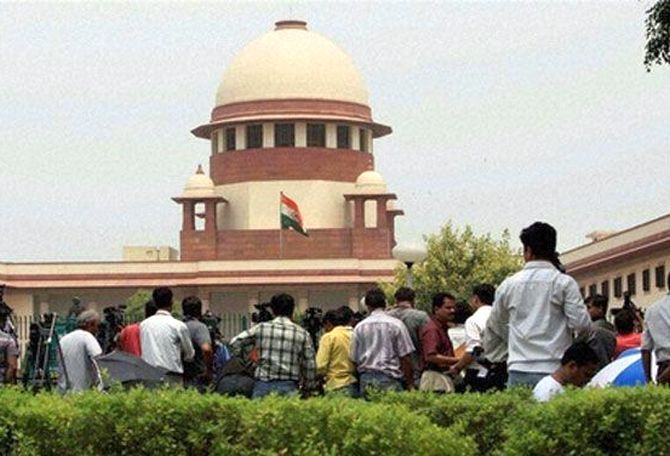Analysis shows that the number of sanctioned judges is adequate and if all the sanctioned judges were appointed, the mounting pendency and huge delays would be history, says Shailesh Gandhi.

Everyone agrees that delays in justice delivery give rise to a large number of problems.
I decided to try and evaluate how many extra judges would be required to start reducing judicial backlogs. The 20th Law Commission in its report submitted in July 2014 concluded that the rate of disposal per judge per year is the right method for evaluating this.
In simple terms it assumes that if 10 judges are disposing 10,000 cases, 12 judges will dispose 12,000 cases. This may not be precise, but it is broadly correct.
I took the data reported by the Law Commission in its report and did an analysis for 2002 to 2012 of 14 states for the subordinate courts it had taken into account.
A careful analysis shows that if all sanctioned positions of judges were filled, there would have been no backlog by 2007.
This would mean the queue would disappear and it would have been possible to devote adequate time to all cases without having to wait.
In most cases it should be possible to dispose cases in less than three to six months. In Australia over 70 per cent of the cases in the magistrate's courts are decided within 13 weeks.
The Law Commission analysis assumed that backlog would be cleared up in three years and did not take the vacant judicial positions into account.
Hence it came to the erroneous conclusion that the strength of the judiciary needs to be doubled.
I decided to also take a look at this issue by analysing the data given on the Supreme Court's website for a 12-year period from 2006 to 2017 (both years included) which has a quarterly report for all the courts.
This analysis has been done by adopting the same rate of disposal method accepted by the Law Commission.
The analysis shows that the number of sanctioned judges is adequate and if all the sanctioned judges were appointed, the mounting pendency and huge delays would be history.
The number of judges sanctioned in the three levels as on December 31, 2017 was 31 for the Supreme Court, 1,079 for the high courts and 22,704 in the subordinate courts. The actual number of judges appointed was 25, 676 and 17,028 at the three levels respectively.
Thus the total number of sanctioned posts were 23,814 whereas the working judges were only 17,729. Filling about 6,000 vacant positions can make the judicial system deliver efficiently.
The increase in pendency in 12 years was about 56 lakh cases whereas the disposal missed due to not filling all sanctioned posts was nearly 661 lakh.
The average increase in cases each year is less than 2.5 per cent of the average number of cases instituted each year, whereas the average vacancy is about 21 per cent.
There can be no excuses for keeping judicial positions vacant while the nation suffers because of this neglect.
The retirement date of judges is well known. It would be possible to factor in vacancies due to resignations, promotions and deaths by studying the past data.
The increase of sanctioned positions can also be forecast early. Looking at the standard deviation in the disposal per judge each year gives us the assurance that the disposal rates in different years are reasonably consistent.
The number of registered advocates is about 1.3 million and over 60,000 graduates emerge each year from our law schools. The infrastructure would need to be augmented by only about 20 per cent.
Even if we assume that there would be a capital cost of setting up courtrooms, this would not exceed Rs 4 crore per courthouse which would mean about Rs 24,000 crore only.
This is a simple solution and can be implemented easily. This does not assume any change in the way judges and lawyers function.
It only assumes that the extra judges who fill the vacancies will also dispose matters at the same rate as those who are already in the system.
While the sanctioned judicial positions are about 19.1 judges per million, the actual working strength is only 13.9 judges per million population.
Surely it can be ensured that this process is started 12 months early. There should be a similar approach for subordinate judges to ensure the selection process is completed in advance.
For the sake of the nation all those responsible must ensure that all judicial appointments are made in a timely manner.
An easy solution is available. This analysis suggests that if a simple process of estimating vacancies and ensuring zero vacancy is followed, the sanctioned strength is adequate to dispose the inflow of cases and some of the backlog.
Even if we assume vacancies would be to the tune of 5 per cent, backlogs would go down dramatically.
If the queue of cases does not keep getting longer, most delays would be reduced considerably.
If the queue is very small there is not much scope for delays.
If a policy decision is taken to ensure zero vacancy in judicial positions, backlogs would become history and the fundamental right to speedy justice would actually be implemented in our courts.
Shailesh Gandhi is former Central Information Commissioner. He acknowledges the contribution of Arun Joshi in the calculations and analysis.











